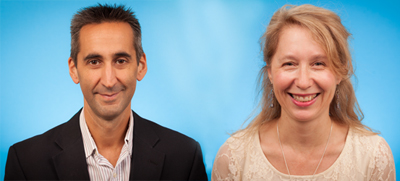Illuminating the experiences of young adults with Type 1 diabetes

By Anna Wassermann

Drs. Andrew Advani and Janet Parsons
Matt Danner was diagnosed with Type 1 diabetes when he was 12 years old. Now a college student and varsity athlete, he says that the hardest adjustment wasn’t learning how to live with diabetes, it was learning how to manage it on his own.
“I left home to go to boarding school when I was 15 or 16, and I had a bit of an adjustment there,” said Danner. “Living away from my parents, playing sports and eating dining hall food, my care was in my hands.”
Danner’s experience is common, particularly among young adults as they learn to manage their Type 1 diabetes while separating from parental care and moving on to higher education or full-time work.
The gap between care provided in childhood and care provided during adulthood can pose particular challenges for young people living with Type 1 diabetes. This shift of care is often called “transition,” and while efforts have been made to smooth the process, health care professionals often struggle to provide care that is developmentally appropriate for this stage of life.
To inform the provision of tailored transition care, a research team at St. Michael’s Hospital set out to better understand the lived experiences of emerging adults with Type 1 diabetes. Published today in JAMA Network Open, the team found three common ways through which emerging adults’ narrate the Type 1 diabetes experience.
“Every person is unique, but there are a number of commonalities in how emerging adults perceive and depict their experiences living with Type 1 diabetes,” said Dr. Andrew Advani, co-senior author and a scientist at the Keenan Research Centre for Biomedical Science. “By understanding these similarities and differences, we hope to help physicians who may be less familiar with the psychosocial contexts in which patients are coping with their condition.”
The idea for this study came about after a patient-led foundation requested that Dr. Advani look into strategies to improve communication between health care professionals and people living with diabetes. A clinical endocrinologist and basic scientist, Advani knew he needed help analyzing patient stories, so he reached out to Dr. Janet Parsons, a scientist in the Li Ka Shing Knowledge Institute. Together, they recruited Ben Markowitz, a graduate student at the University of Toronto.
To explore how young adults’ experience Type 1 diabetes, Markowitz conducted interviews with 33 patients in the young adult diabetes clinics at Women’s College Hospital and St. Michael’s.
More than halfway through the interviews, Markowitz realized that there were three broad ways in which patients were articulating their stories. This realization led him to develop the “3i conceptual framework,” which classifies patients’ experiences through one of three lenses – ingrained, intrusive or inconspicuous.
“The ingrained and intrusive lenses came about first, and they refer to patients who perceive their diabetes either as part of their norm, or as a burden,” said Markowitz. “The inconspicuous lens, which came about last, refers to patients who say they try not to notice their diabetes or make it noticeable to others.”
While the researchers say that they realize human behaviour is more complicated than the categorical way they framed it, Dr. Advani said that the 3i conceptual framework could provide clinicians with a simple way to recognize that different people experience the same medical condition differently.
“Diabetes management in early emerging adulthood is really the intertwining between the biomedical and the social contexts,” said Dr. Advani. “To provide suitable care, it’s important for providers and educators to be able to appreciate the social context in which the medical condition is being experienced.”
As a patient, Danner says he couldn’t agree more. Over the years, his health care providers have taken the time to get to know him, and he says this has helped ease his transition into early emerging adulthood.
“When you’re able to talk to your doctors or your nurses and they take the time to get to know you, it makes a huge difference,” said Danner. “The smoother you can make the life of someone living with diabetes, and the smoother you can make any transition for them, the greater the long-term benefits.”
Funding for this project was provided through the RDV Foundation, St. Michael’s Foundation, Alternative Funding Plan Innovation funds from the Ontario Ministry of Health and Long-term Care and a Queen Elizabeth II Graduate Scholarship in Science and Technology.
This paper is an example of how St. Michael’s Hospital is making Ontario Healthier, Wealthier, Smarter.
About St. Michael’s Hospital
St. Michael’s Hospital provides compassionate care to all who enter its doors. The hospital also provides outstanding medical education to future health care professionals in more than 27 academic disciplines. Critical care and trauma, heart disease, neurosurgery, diabetes, cancer care, care of the homeless and global health are among the Hospital’s recognized areas of expertise. Through the Keenan Research Centre and the Li Ka Shing International Healthcare Education Centre, which make up the Li Ka Shing Knowledge Institute, research and education at St. Michael’s Hospital are recognized and make an impact around the world. Founded in 1892, the hospital is fully affiliated with the University of Toronto.
About Unity Health Toronto
Unity Health Toronto, comprised of Providence Healthcare, St. Joseph’s Health Centre and St. Michael’s Hospital, works to advance the health of everyone in our urban communities and beyond. Our health network serves patients, residents and clients across the full spectrum of care, spanning primary care, secondary community care, tertiary and quaternary care services to post-acute through rehabilitation, palliative care and long-term care, while investing in world-class research and education. For more information, visit www.unityhealth.to.
